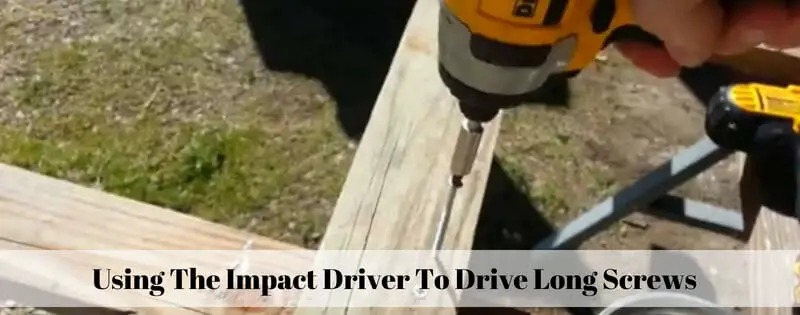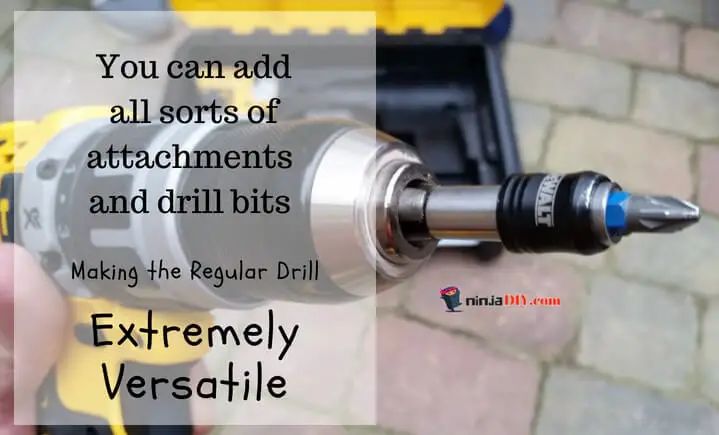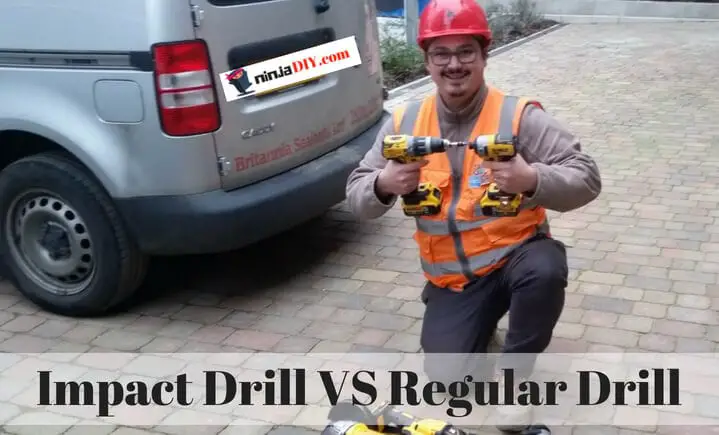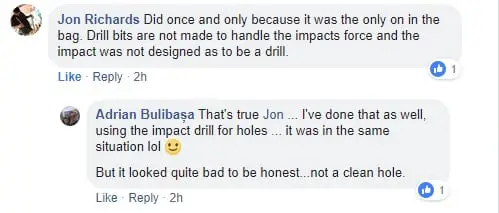How many times have you asked yourself this question?
What is the difference between an impact drill and a regular drill?
A few times?! Yeah … same here a few years back.
Well…I’ve come up with this article in order to make it clearer for you as well. Just as someone else did it for me a couple of years back when I was a bit confused with so many tools looking and doing the same thing but they have different names.
In this Impact Drill VS Regular Drill article I’ll talk about some differences between these two and some pros and cons. As well I’ll try to answer some other few frequent questions about these two tools.
Quick View Of The Differences Between An Impact Drill and A Regular Drill
What Is An Impact Driver/Drill Used For
So let's talk a little bit about both of them.
Impact drills drive screws via hammering action and rotational motion.
This makes it way easier to drive screws into tough materials. It also prevents the drill bit from slipping off the screw head, which could potentially strip the head and ruin the screw.
An impact drill is designed with a collet that only accepts hex-shanked driver bits. Don't know what hex driver bit is?! Here's a link to Amazon if you want to have a quick look at what it is.
1. Designed to drive screws, faster and easier than any other drill
Impact drivers can be used to drive large fasteners that include fat lag screws that often stall typical drivers.
Impact drills work via bit rotation and sheer concussive power to drive screws through materials of varying density and thickness.
The result of this combination is raw power.
Impact drivers achieve two to three times more torque than your average drill or driver.
To drive in screws using an impact drill, you just need to apply enough pressure to keep the screw guided on a single point.
2. Despite the brute strength, impact drivers are comfortable to work with
This can be attributed to the concussive action which transfers most of the torque directly onto the screw and not to your wrist or forearm.
Most impact drivers do not have a slip clutch, therefore the concussive action allows you to drive screws with great power and precision.
Impact drill action, is really loud, with a repetitive clicking noise as it drives in a screw.
That noise is the hammering action, and it occurs dozens of times per second, depending on how fast you’re driving in the screw.
It can also come in handy when removing stubborn screws or bolts when used in the reverse spin direction. The hammering action can make it a great deal easier to remove corroded or over-torqued fasteners.
Impact drivers are ideal for numerous tasks such as building shelves, installing tile backer boards, and screwing down plywood boards.

The impact drivers comprise a heavy outer sleeve surrounding a splined inner core. The splined inner core is intentionally curved so that when the outer heavier sleeve is struck, the downward force on the spline produces a turning force on the core and consequently to any socket or work bit attached to it.
The tool is designed to translate heavy rotational inertia of the heavier sleeve to the lighter core thereby generating huge amounts of torque.
3. Impact drivers are not normally recommended for use on precise drilling projects
... a power drill can do a better job at that.
This is because you don’t need hammering action when drilling. Also, incorporate a quick sleeve change mechanism that only accepts bits with quarter inch hex shanks.
- Impact drivers are built with only one gear meaning you have to be very precise with the variable-speed trigger when working with this tool.
- Power drills, on the other hand, have two gears: one that’s slower with more torque for driving in screws, and a second gear that’s faster for drilling holes.
Impact drivers traditionally don’t have clutches. This means the quality of work will depend on the strength and precision of your hands. Impact drills are great for driving screws. They are more compact and lightweight.
Pros And Cons Of The Impact Drill
Regular Drill | Do I Need A Regular Drill If I Have An Impact Driver?
Regular drills run on smaller motors which produce way less power compared to impact drivers.
As I've mentioned in the table above an impact driver it was mainly designed to do one type of job and that is to
- drive screws and bolts with a lot of power and very little force from your part.
Whilst a drill was designed to
- be more versatile
These drills work exceptionally well on wood, soft walls, plaster and any other type of softer material. A regular drill has less power thus allowing you more control and lets you make small precise holes.
These tools are for simple tasks that do not require much torque
Regular drills have a chuck, which is a device on the end of the drill that consists of claws that can open and close to accept all different sizes of drill bits.
Drills have an inbuilt clutch, which is similar to having a built-in torque wrench of sorts. The mechanism allows you to drive screws without the risk of accidentally tightening it down too much and blasting through the material.
Regular drills are affordable, versatile, and are perfect for drilling holes and driving screws. It comes in various sizes as well as voltages and can also be corded or powered by lithium-ion batteries.
The main defining factor you need to know about a regular drill is that you can swap out the working bits

Most modern regular drills tighten by using leverage. Many such drills use keyless chucks which means you can tighten them using your hand. However, some regular drills require the use of a “key” to tighten the chuck.
Most regular drills have two torque settings
- When the torque settings are at the lowest, the drill tightens screws until a small amount of tension is achieved. Afterward, the drill starts clicking rapidly.
- When the torque settings are at the highest setting, the drill will continue tightening the screw until it slips off. It is recommended to start with low to medium torque settings. Then, if need be, adjust accordingly.
There are different types of drill bits for different types of material
The most common are
- General-purpose drill bits: These have a simple head and are commonly used for basic household repair and maintenance projects.
Others include
- Flat bits also called spade bits. These are often used in professional construction projects in tasks such as framing bolt-holes in wood.
- Masonry bits which are used when working with concrete.
- Brad point bits used in dowel projects.
- Diamond carbide tipped bits: These are used for drilling into tough materials such as porcelain.
When drilling holes for screws, ensure that you use the correct size of drill bit. To achieve this, hold up your drill bit with the screw in front of it. Make sure you can see all of the screw’s threads behind the drill bit. The drill bit should also be about the same size as the screw’s body while being smaller than your screw’s threads.
When you intend to drill a large hole, make a smaller “pilot hole” to help guide the drill bit and protect the material from cracking.
Pros And Cons Of The Regular Hammer Drill
Drill chuck and chuck keys
The chuck on regular drills refers to the adjustable mechanism that allows the user to attach and tighten the drill bit.
This mechanism allows the tool’s user to switch out drill bits depending on the nature of the project. Newer variations of regular drills are keyless, where the drill or screwdriver bit can be directly inserted into the spindle and securely fastened by hand.
Chuck keys lock onto the grip around the bit and hold. The key chucks are however not attached to the drill itself and can get lost or be misplaced. Without the all-important key, the drill bits cannot be changed.
Trigger switch and forward/reverse mechanism
A trigger switch refers to the on-and-off mechanism on a regular drill. Some drill models come equipped with an only one-speed setting and hence one simple switch. Other types of drills have variable speed settings that can be toggled with respect to the trigger switch, allowing the drill to spin at a faster or slower pace. A typical variable speed trigger switch allows the user to control the speed of the drill by simply pressing harder on the trigger.
The forward and reverse switch makes possible the removal of screws or their replacement once they are secured. The same mechanism is for drilling/driving in while the reverse is for pulling out.
Drill shaft and drill bits
The drill shaft is the part of the drill that holds together the motor and the chuck itself. It is the part of the drill where the rotating clutch is located. Similar to most electrical motors, regular drills operate using a clutch mechanism to control the power output.
The clutch can be adjusted to multiple settings for varying drilling power.
The drill bits are typically changed according to the needs of the project at hand. Different drill bits can be used for tasks such as boring, etching and hole sawing. It is utterly essential to be careful when using drills and power tools for that matter. Work slowly and be sure to use eye protection.
When making holes on drywall ensure you use drywall anchors.
Here's a short video from youtube where you can see some of the differences
Impact Drill VS Regular Drill ... Which One Do I Need?
Conclusion
Both impact drills and regular drill are well-sought after tools for both professional and DIY projects.
Each one has its own merits and as such, it would be inappropriate to rule out the usefulness of one over the other.
Just as in the video, if you ask me which one do you need, the impact drill or the normal drill ... I would say both :)
Or
Depending on what you are planning to do with these tools or what your background is.
- If you are a home improvement DIYer and you like to do things around the house I would say that having a regular drill is enough. Honestly, there are very few jobs for you to do with an impact drill at home. But if you have the budget I would say to have a look at getting yourself a nice power tool kit that includes all these tools. If not ... a regular drill is enough.
- And if you are a PRO within the construction industry or even a mechanic ... HAVING BOTH TOOLS IT'S A MUST!!!
I will keep adding to the below Q&A section over time. If you have a specific question that is not addressed here ... drop your's in the comments and I'll make sure to answer it for you.
Sounds cool?
Awesome. Thanks for stopping by and hope to see you around.
In the meantime...
...Stay Safe Ninjas And Happy DIYing :)

Q&A Related To Impact Drills VS Drivers/Drills
Q: Can you use an impact driver as a drill?
A: I would suggest you NOT TO. If you have both of these tools when it comes to doing delicate jobs like installing the hinges in a kitchen cabinet door or any of this kind of little delicate jobs...you don't need the brute force of an impact driver. It will damage your work.
When I've put this question in one of the best groups on Facebook related to DIY, Woodworking for Beginners Tips, Tricks, DIY Projects & Tools ... this is what some users have said:


Q: What is an impact drill used for?
A: Honestly, most of the times it is used by professionals. Rarely a DIYer or a homeowner has an impact driver in his/her toolbox. It's been used mostly for the guy working with drywall, but not limited to that of course. Basically, an impact driver it is used to drive screws, tighten bolts and everything similar to this where raw power is needed either to remove a screw or bolt or to drive it.
Q: What is the difference between a hammer drill and an impact drill?
A: The main and plain difference between these two is that the impact driver is for driving screws and the hammer drill is for making holes (especially in hard surfaces like concrete, blocks, bricks, etc)
- The hammer drill has the capacity of spinning the bit and at the same time hammering the bit forward at very high speeds making drilling holes into stone, concrete, etc ... easier.
- The impact driver it's uses something unique and that is called concussive force and what this does differently from the hammer drill is that when you are driving a screw, the impact driver won't pound on the screw-like the hammer drill will ...
... the screw it's been pounded from the side.
Q: Can I Use An Impact Driver As A Hammer Drill?
A: You could if you wanted to ... but I don't recommend it. And that is because the holes will look a bit messy, it won't be a nice, clean hole. So if you need to make a precision whole ... use the hammer drill ...NOT the impact driver.







Such an amazing post !! It gives me information that I’m looking for, thanks for sharing 🙂
Hey Thomas.
Thanks for leaving a comment. I’m happy to hear that it helped.
By the way … what do you prefer? Impact Driver or Regular Drill …
… or you are like me and use both of them? 🙂